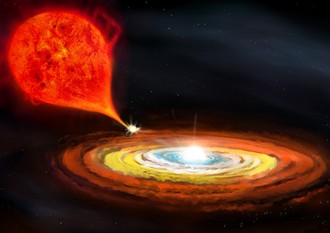
Dwarf novae are cataclysmic variables (CVs), which are close binary systems containing a white dwarf primary and a secondary star that fills its Roche lobe. The secondary is typically a low mass main sequence star that loses its material through the inner Lagrangian point. In the presence of a weakly-magnetic white dwarf, this material forms an accretion disc around the white dwarf.
One of the most intriguing classes of dwarf nova is the SU UMa type, whose have short orbital periods (of shorter than 2.5 h) and display two types of outbursts called normal outbursts and superoutbursts. Superoutbursts are typically about one magnitude brighter than normal outbursts, occur about ten times less frequently and display superhumps – characteristic tooth-shaped light modulations with a period a few percent longer than the orbital period of the binary.
HT Cassiopeiae was discovered over seventy years ago and classified as a U Gem type star with brightness varying between 13.0 and 16.5 mag. For 35 years this dwarf nova received very little attention, until the eclipses of HT Cas were noticed for the first time. After this, Patterson made HT Cas a top priority object for an observing season in 1978. Three years later, the results of this campaign were published where the first precise ephemeris of eclipses, ingress/egress times, inclination and mass ratio were presented. Additionally, Patterson characterized HT Cas as "the Rosetta stone of dwarf novae". Over 30 years from this statement, the literature about this unique eclipsing binary star is still growing, reaching several do zens of publications and several PhD theses.
In November 2010 HT Cas went into superoutburst, which happened a quarter of a century after the previous, poorly observed, superoutburst. All these recent events were our motivation to make a detailed an alysis of the hot spot and to verify the theory of superhump and superoutburst mechanisms.
In a recent paper "Hot spot manifestation in eclipsing dwarf nova HT Cassiopeiae", K. Bakowska and A. Olech (of the Copernicus Center) report the detection of the hot spot in light curves of the eclipsing dwarf nova HT Cassiopeiae during its superoutburst in 2010 November. Analysis of eight reconstructed light curves of the hot spot eclipses showed directly that the brightness of the hot spot was changing significantly during the superoutburst. Thereby, detected hot spot manifestation in HT Cas is the newest observational evidence for the EMT model for dwarf novae and conradict the TTI model which assumes conctant mass transfer rate from the secondary.
Picture: an artist vizualization of the sysyem.






